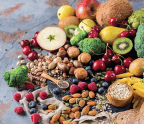Midweek Dinners

Black Lentil Dhal with Beetroot Raita
Serves: 4
Perfect comfort food, this hearty dhal is similar to the classic Punjabi dal makhani, but uses green lentils instead of the more usual red kidney beans. The benefits of using dried green lentils alongside the urad dhal (black lentils) is that neither need pre-soaking or cooking, so you can assemble the ingredients and turn on the slow cooker first thing and you’ll be welcomed home with the wonderful aroma of dhal.
• 1 tbsp coconut oil
• 1 large onion, finely chopped
• 3 garlic cloves, finely chopped
• 4-cm/1½-in piece root ginger, grated
• 2 tsp cumin seeds
• 1 medium-sized green chilli, deseeded and finely chopped
• 3 cardamom pods, split
• 1 small cinnamon stick
• 1 tsp turmeric
• 200g (7oz) whole black lentils (urad dahl), rinsed
• 55g (1.9 oz) dried green lentils, rinsed
• 2 tsp vegetable bouillon powder
• Good squeeze of lemon juice
• 1 handful coriander, to serve
• Wholewheat chapattis, to serve
For the beetroot raita:
• 1 raw beetroot, grated
• 100g (3.5 oz) white cabbage, shredded
• 1 carrot, grated
• 1 small eating apple, cored and grated
• Juice of 1 small lemon
• ½ small red onion, diced
• 100ml (3.3 fl oz) live plain vegan yoghurt
• Sea salt and cracked black pepper
1 Put all the ingredients up to and including the green lentils in the slow cooker pot. Pour in 700ml (1.2 pints) hot water and stir until combined and the coconut oil melts.
2 Cover and cook on low for 7-8 hours, or high for 5-6 hours, until the lentils are tender.
3 To make the beetroot raita, mix together all the ingredients in a bowl and season.
4 Just before serving the dhal, stir the bouillon powder into the dhal and add a good squeeze of lemon juice. Add a splash more hot water if it’s too dry – you want it to have a thick, soupy consistency – if too wet, take off the lid and cook on high for 15 minutes. Taste and add extra salt and pepper, if needed.
5 Serve the dhal in shallow bowls, topped with a spoonful of the beetroot raita and a sprinkling of coriander, with warm chapattis by the side.

Super Three-Tomato Sauce
Makes: about 1-1.5L
The success of this richly flavoured tomato sauce relies on the quality of the raw ingredients as well as cooking it low and very slow – the longer you cook the sauce, the richer and more intensely flavoured it becomes. Serve it with pasta or, alternatively, use as a base sauce for vegetables.
• 4 tbsp olive oil
• 2 onions, finely chopped
• 3 large garlic cloves, finely chopped
• 700g (1.5 lb) vine-ripened tomatoes, cut into thin wedges, retaining the vines
• 2 x 400g (14.1 oz) cans plum tomatoes
• 60g (2.1 oz) sun-dried tomatoes in oil, drained and roughly chopped
• 15g (0.5 oz) basil sprigs
• Sea salt and
You’re reading a preview, subscribe to read more.
Start your free 30 days

